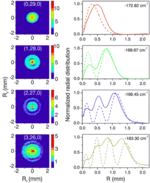In order to describe the microscopic properties of matter and their interactions with the environment, quantum mechanics uses wavefunctions whose structure and time dependence are described by the Schrödinger equation. In atoms, using electronic wave functions, i.a. Describe charge distributions whose magnitude is far removed from our everyday experience. The experimental observation of the charge distribution is complicated by the fact that the process of measurement itself has effects on the wave function and each measurement selectively detects only one manifestation of the possible states. Physicists therefore use calculations of charge distributions that are possible with textbook knowledge. Better said, until today this was so. Under the leadership of MBI scientists, an international team of researchers has succeeded in developing a microscope that allows the wave function of excited hydrogen atoms to be increased by a factor of more than twenty thousand. Thus, the node structures of the electronic states of the hydrogen atom can be visualized on a two-dimensional detector. The results of the work represent the realization of a three-decade-old idea and were published in Physical Review Letters (PRL 110, 213001 (2013) and on physicsworld.com.
The development of quantum mechanics in the first half of the last century had a significant impact on the scientific understanding of the world. Quantum mechanics extended the world view based on classical Newtonian mechanics to a description of the micro-world, whose properties could not be explained by classical approaches. These properties include e.g. the particle-wave-duality, the interference and entanglement of particle properties, the Heisenberg uncertainty principle and the Pauli exclusion principle. Of central importance in quantum mechanics is the concept of wave function, which allows a mathematical solution of the time-dependent Schrödinger equation. According to the Copenhagen interpretation, the wave function describes the likelihood of measurement results resulting from a quantum mechanical system, such as a. the energy of a system or the position and momentum of its components. The wave function thus allows the description of non-classical phenomena on the microscale, which are observed by measurements on the macroscale. The measurement corresponds to viewing one or more of the innumerable possible manifestations of the wave function.
Despite their tremendous impact on modern electronics and photonics, quantum mechanics and its potential still pose great intellectual challenges. Again and again, new experiments were inspired to illustrate the fascinating predictions of the theory. For example, Haroche and Wineland received the Nobel Prize in 2012 for their work on measuring and controlling single quantum systems in interference-free quantum experiments, paving the way for more accurate optical clocks and possibly even for the future realization of a quantum computer. Using short laser pulses, coherent overlays of stationary quantum mechanical states (waves) of the electrons moving on periodic orbits around atomic nuclei can be observed in experiments. The wave function of each of these electronic stationary states is a standing wave, which has a node pattern in which the quantum numbers of the respective states are reflected. To observe such nodal patterns, raster tunneling techniques have been applied to surfaces. In addition, recent laser ionization experiments have enabled the generation of extreme UV light which encodes the initial wave function of an atom or molecule at rest.
